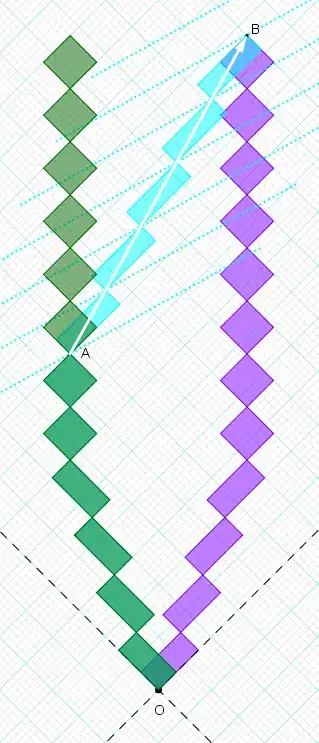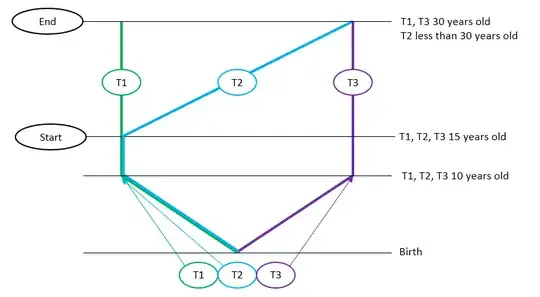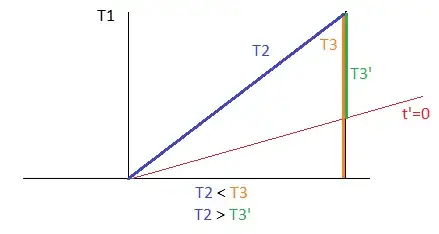UPDATE:
I noticed the first sentence and wanted to make a comment on it.
Here is a variation of Twin Paradox. I call it Half (for bottom half of Twin Paradox) Triplet Paradox with no change of inertial frames involved.
In the scenario you described the three travelers T1, T2, and T3 from "birth" to "end" are non-inertial. Although they are piecewise-inertial, any kink in the worldline renders the traveler non-inertial [since a ball on a frictionless table in their ship will move at the kink event].
Only a traveler with a forever-straight worldline on a spacetime diagram (like one that could be drawn in the lab frame below) is inertial.
If you restrict consideration to the portion between "start" and "finish",
then they are inertial.
Here's a spacetime diagram on rotated graph paper
so that we can more easily read off the ticks.
The light-clock diamonds are traced out by the light-signals
in an observer's light clock.
The area of all light-clock diamonds are equal, in accordance with the principle of relativity.
I've done my best to try to model the OP's scenario.
In the following, each diamond (1 tick) represents 2.5 years.
The speeds at the initial separation are $|v|=5/13$,
which corresponds to time-dilation factor $\gamma=\frac{13}{12}\approx 1.0833$,
and Doppler factors of $k=\pm 3/2$
(rational $k$'s are associated with Pythogorean triples,
which make the arithmetic simpler).
[$k$ is an eigenvalue of the Lorentz boost and describes the reshaping of the light-clock diamond, by stretching by $k$ in the forward direction and shrinking by $k$ in the backward direction, preserving the area. (Recall the determinant of a boost is 1 and the eigenvectors are along the light cone.)]

You can count the ticks (each representing 2.5 years) along these piecewise-inertial worldlines.
T2 traveled at (5/9)c in order to meet T3 at T3's 30th birthday.
The lab-coordinates of events A and B are $A=(t=6.333,x=-1.666)$
and $B=(t=12.333,x=1.667)$.
T2's last leg has $\Delta x=10/3$ ticks and $\Delta t=6$ ticks in this frame.
( $\gamma=\frac{1}{\sqrt{1-v^2}}=\frac{9}{2\sqrt{14}}\approx 1.20267$.
So, $(6/\gamma)=\frac{4\sqrt{14}}{3}\approx 4.9888$.)
Thus, T2 elapsed $\sqrt{6^2-(10/3)^2}=\sqrt{224/9}\approx 4.9888 $ ticks = $12.4722$ years.
So, T2 is $15+12.4722=27.4722$ years old
when T2 meets T3 at T3's 30th birthday.
A lab observer who is at rest and meets event B
has age 12.333 ticks $\approx 30.8333{\rm\ years}$.
I've drawn in T2's lines of simultaneity,
which are parallel to the spacelike diagonals of T2's diamonds.
Note that 4 ticks after T1 and T2 separate:
- T1 says "when 4-ticks on T1's clock have elapsed, T2 has not yet elapsed 4-ticks on T2's clock"
- T2 says "when 4-ticks on T2's clock have elapsed, T1 has not yet elapsed 4-ticks on T1's clock"
(For an elaboration of the symmetry of time-dilation, refer to my answer
https://physics.stackexchange.com/a/383363/148184
in How can time dilation be symmetric? )
These diagrams are based on methods described in my paper
"Relativity on Rotated Graph Paper"
Am. J. Phys. 84, 344 (2016)
https://doi.org/10.1119/1.4943251
( early draft: https://arxiv.org/abs/1111.7254 )
See also https://www.physicsforums.com/insights/relativity-rotated-graph-paper/
In addition, I mentioned
Twin paradox problem from a perverse perspective in the comment to the OP.
Yes, this situation is due to Special Relativity.
These diamonds are precisely traced out by the associated light clocks,
which are constructed according to the principle of relativity and the constancy of the speed of light.
From this construction visualized on a spacetime diagram,
one can likely come up with all sort of valid ways of thinking
about how these results occur (e.g. time dilations, length-contractions,
doppler effects, Lorentz transformations, etc...).
Why is it like this?
This is our universe as we understand it,
and is well supported by a huge amount of experimental data.
The Galilean framework with absolute time and absolute length
and its associated predictions
are not supported by experimental data, especially at high relative speeds.
Someday we may have super-high-precision watches where these effects
can be measured at lower relative speeds.


